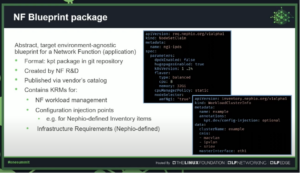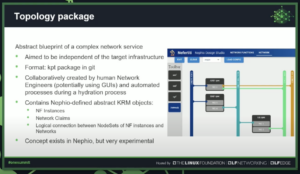Understanding the practical challenges and opportunities of new tech is crucial to evolving network automation. István Kispál, a Nokia Bell Labs Distinguished Member of Technical Staff, shared his experience using LFN’s Nephio to manage a real-world Nokia 5G core during ONE Summit 2024.
Why This Matters
Kispál outlines how Nokia uses Nephio’s Release 2 to deploy and operate a Nokia 5G core (that is identical to a commercial offer on AWS).
He describes the network functions’ topology by using a generic, target environment-agnostic blueprint. Through the collaboration of automated processes and human engineers, Kispál and his team transformed this blueprint into an AWS and Nokia-specific deployment package. This package was then deployed to AWS using a GitOps tool.
Key takeaways from Nokia’s deployment can serve as essential information for those looking to implement Nephio or even contribute to its development.
Setup and Initial Steps:
- Deployed a 5G core, part of Nokia’s actual offering, into a public cloud (AWS) using Kubernetes clusters.
- Managed cloud infrastructures and network function (NF) lifecycle via Crossplane, leveraging Kubernetes Resource Model (KRM)-based management.
- Adopted an opinionated deployment strategy involving a single workload cluster, single VPC, and dedicated node groups for each NF instance.
Learnings:
- NF Blueprints: Adapting existing custom resources to Nephio-compatible blueprints required major changes, showing the complexity of integrating new automation frameworks.

- Managing Complex Topologies: Describing and handling intricate network topologies was challenging. Kispál used Nephio’s existing concepts with needed adjustments, highlighting the need for flexible and detailed topology management.

- Automated Lifecycle Management: Successful one-click deployment and lifecycle management of the 5G core required new features, like automatic calculation of infrastructure changes and abstract descriptions of infrastructure requirements.
- Infrastructure and Deployment Strategies: The project points to the need for effective strategies for managing deployments across multiple nodes and infrastructure providers. Introducing concepts like node steps and supporting a variety of providers was crucial.
- Potential: Despite current gaps, Nephio’s principles were validated in a real-world scenario. Continued development and community collaboration are needed to help Nephio fulfill its promise.
The Nokia case study demonstrates Nephio’s principles in a real-world, 5G setup in flexibly managing complex network functions, and this case study is just one example. Nephio offers the potential for even more automation and reduced complexity across cloud native networks.
Follow LFN’s channels for updates on Nephio, and watch István Kispál’s entire presentation on the LFN YouTube channel to learn more.